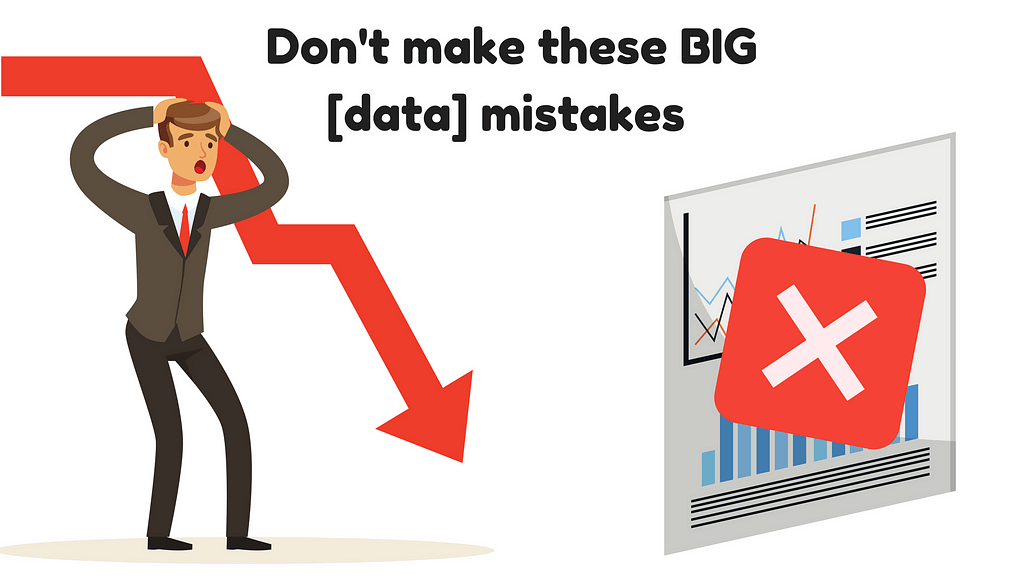Latest news about Bitcoin and all cryptocurrencies. Your daily crypto news habit.

Have you taken the plunge and invested in analytics yet? Are you a large company getting ready to take on a data science initiative? Are you a small, growing company looking for an edge? Are you a data scientist by trade? Whatever category you fall into, there’s something really important you should know:
There are as many ways to fail at analytics as there are to win at analytics.
Yes, even data scientists can fail at analytics. As a company that provides data analytics services, we’ve seen it all (and have even experienced some mistakes of our own). If you’re serious about getting something meaningful from your data, avoid making these common mistakes.
Not correctly identifying the problem first
Tackling a data analytics project should be no different from developing software, creating a mobile app, or starting a new initiative. Before you do anything, answer this one very important question: What problem are you trying to solve? What is it your organization really needs to know in order to move the needle and make the most impact in your organization?
Too often, businesses get caught up in the potential that data analytics holds rather than looking for a clear business need first. You can collect data all day long, but it’s pointless if you don’t know why you’re collecting it and what to do with it once you’ve got it.
Not developing a data strategy
Throwing things at the wall to see what sticks rarely works. Collecting data and then hoping you’ll glean some important insights from it is no different. You need to develop a data strategy that details why you’re collecting the data, what it will be used for, who will have access to it, and how it will be maintained and collected. You’ll want to include privacy concerns and how you intend to protect your data in your strategy, too. In some industries, having clear privacy protections in place may even be a legal requirement.
Not spending enough time on the process
You can have a clear understanding of why you want data and your vision for how to collect it and use it — and still completely fail when it comes to execution. Taking on a data analytics initiative is a huge investment of resources. If you’re going to take on the expense, make sure you spend time on the process.
Weighing your options to determine the right modeling methodology to use is an important part of that process. Data science is more than machine learning. There are lots of methodologies to choose from. Take a step back and become familiar with other techniques (or hire someone who can), and don’t anchor to one technique too early.
Not structuring your organization to be successful at analytics
To be successful, you need more than executive sponsorship (which many companies don’t even have); you need someone at the helm. Designate a person to be in charge of your data strategy and guide it in the right direction. Your designated person needs to be at the top asking questions, building a data-driven culture, and ensuring that everyone from IT to developers to management and marketing are working together.
Everyone in your organization needs to eat data for breakfast. It’s that important. Develop a culture of people — in every department — who are not only data literate but who make outcome-based decisions. Data is for everyone.
Not having a data governance plan
As you’re deciding which systems to use and getting the processes in place, before you start to compile data, you need to make sure you have a data governance plan. Your team needs to understand that data is a living and evolving organism. It needs to be collected and used responsibly and be well maintained. After all, depending on your industry, you may have legal requirements for how you protect your data, especially if you’re collecting personal information from individuals. And then there is the public relations fallout that inevitably happens with a large data breach. The hit to your reputation, infrastructure, and systems can cost hundreds of thousands of dollars.
Best to practice good governance and be prepared up front.
Not integrating all your data
Integrating all your data sources is one of the most important things you can do if you really want to see the big picture. Why work in silos when everyone can share and learn from the data being collected? Not integrating your data means you’ll be missing pieces of the puzzle. It also means that certain departments could be missing out on the benefits of your newly collected data.
If you’re looking for big ways to differentiate your organization from your competitors, analytics are key because of the insights and operations efficiencies you can discover in the data. But only if you use it correctly. Don’t put money into data analytics if you’re not going to fully commit. Believe us when we tell you, it will only end in tears. Don’t make grown men and women cry. Commit to doing it right from the beginning, and avoid these huge mistakes so you don’t waste everyone’s time and money.
How to Fail at Analytics was originally published in Hacker Noon on Medium, where people are continuing the conversation by highlighting and responding to this story.
Disclaimer
The views and opinions expressed in this article are solely those of the authors and do not reflect the views of Bitcoin Insider. Every investment and trading move involves risk - this is especially true for cryptocurrencies given their volatility. We strongly advise our readers to conduct their own research when making a decision.
